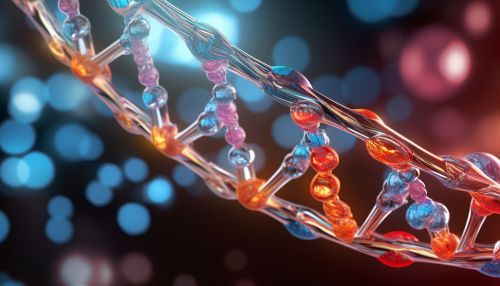Sigma factor
Overview
Sigma factors are a class of proteins found in bacterial cells that play a crucial role in transcription, the process of synthesizing RNA from a DNA template. They are a component of the bacterial RNA polymerase complex and are responsible for the initiation of transcription by recognizing and binding to specific promoter sequences in the DNA.
Structure
Sigma factors are proteins that typically range in size from 20 to 70 kDa. They are composed of four distinct regions, designated σ1, σ2, σ3, and σ4, each of which plays a unique role in the function of the sigma factor. The σ2 and σ4 regions are involved in recognizing and binding to the promoter sequences in the DNA, while the σ1 and σ3 regions are involved in the regulation of sigma factor activity.
Function
Sigma factors are essential for the initiation of transcription in bacteria. They are a component of the RNA polymerase complex, which also includes the core RNA polymerase. The sigma factor guides the RNA polymerase to the correct promoter sequences in the DNA, where transcription begins. Once the RNA polymerase has initiated transcription, the sigma factor dissociates from the complex and can be reused in another round of transcription initiation.
Types of Sigma Factors
There are several types of sigma factors, each of which recognizes and binds to different promoter sequences. This allows the bacteria to regulate the expression of different genes in response to various environmental conditions. The primary sigma factor, often referred to as the "housekeeping" sigma factor, is responsible for the transcription of genes required for normal cellular function. Other sigma factors, known as alternative sigma factors, are activated under specific conditions and regulate the transcription of genes involved in responses to stress, starvation, heat shock, and other environmental changes.
Regulation
The activity of sigma factors is tightly regulated to ensure that genes are transcribed at the appropriate times and in response to the appropriate signals. This regulation can occur at several levels, including the synthesis and degradation of sigma factors, the binding of sigma factors to the RNA polymerase, and the activity of anti-sigma factors, which bind to sigma factors and prevent them from initiating transcription.
Role in Bacterial Pathogenesis
Sigma factors also play a crucial role in bacterial pathogenesis. Many pathogenic bacteria utilize alternative sigma factors to regulate the expression of virulence genes in response to host signals. This allows the bacteria to adapt to the host environment and to evade the host immune response.
See Also


